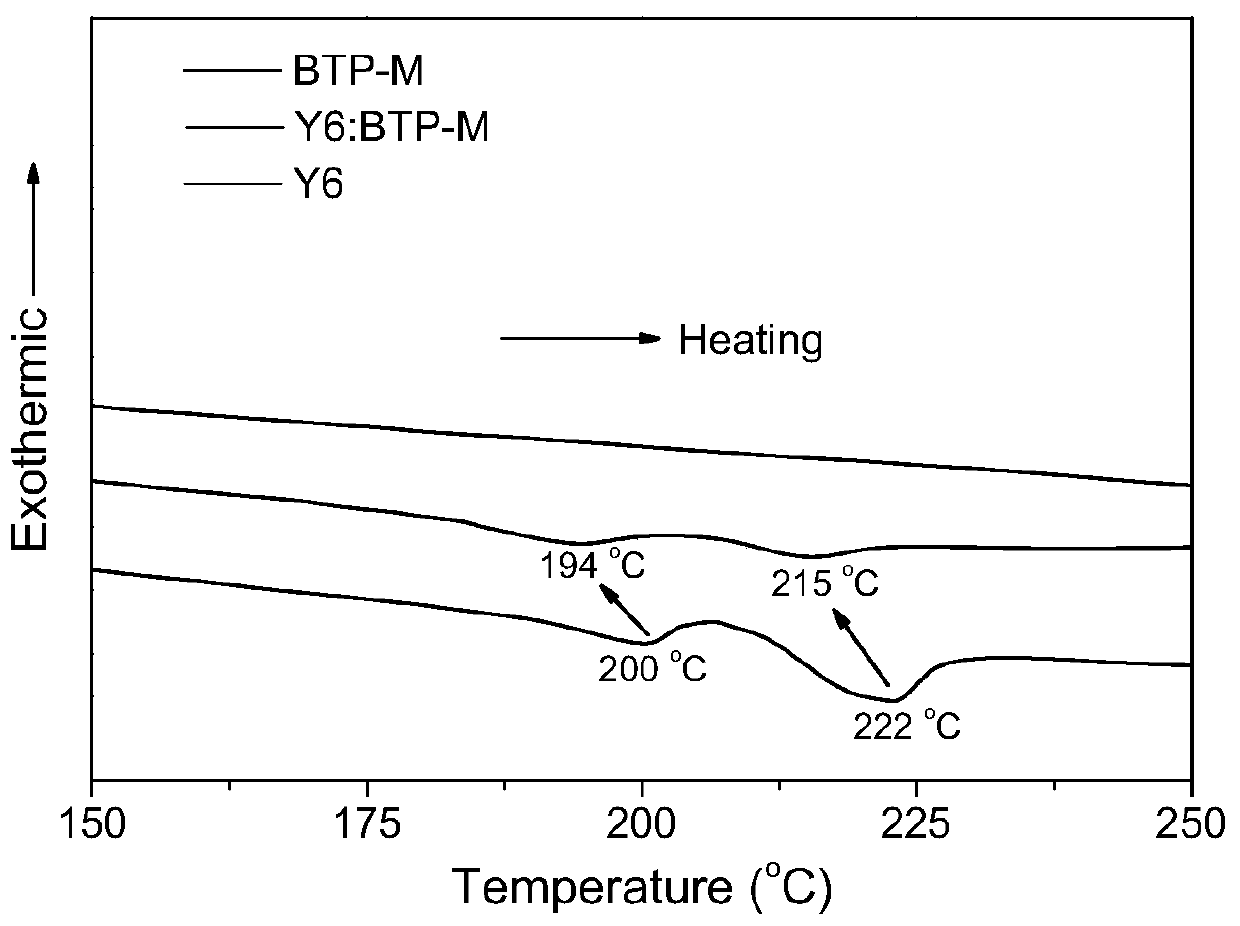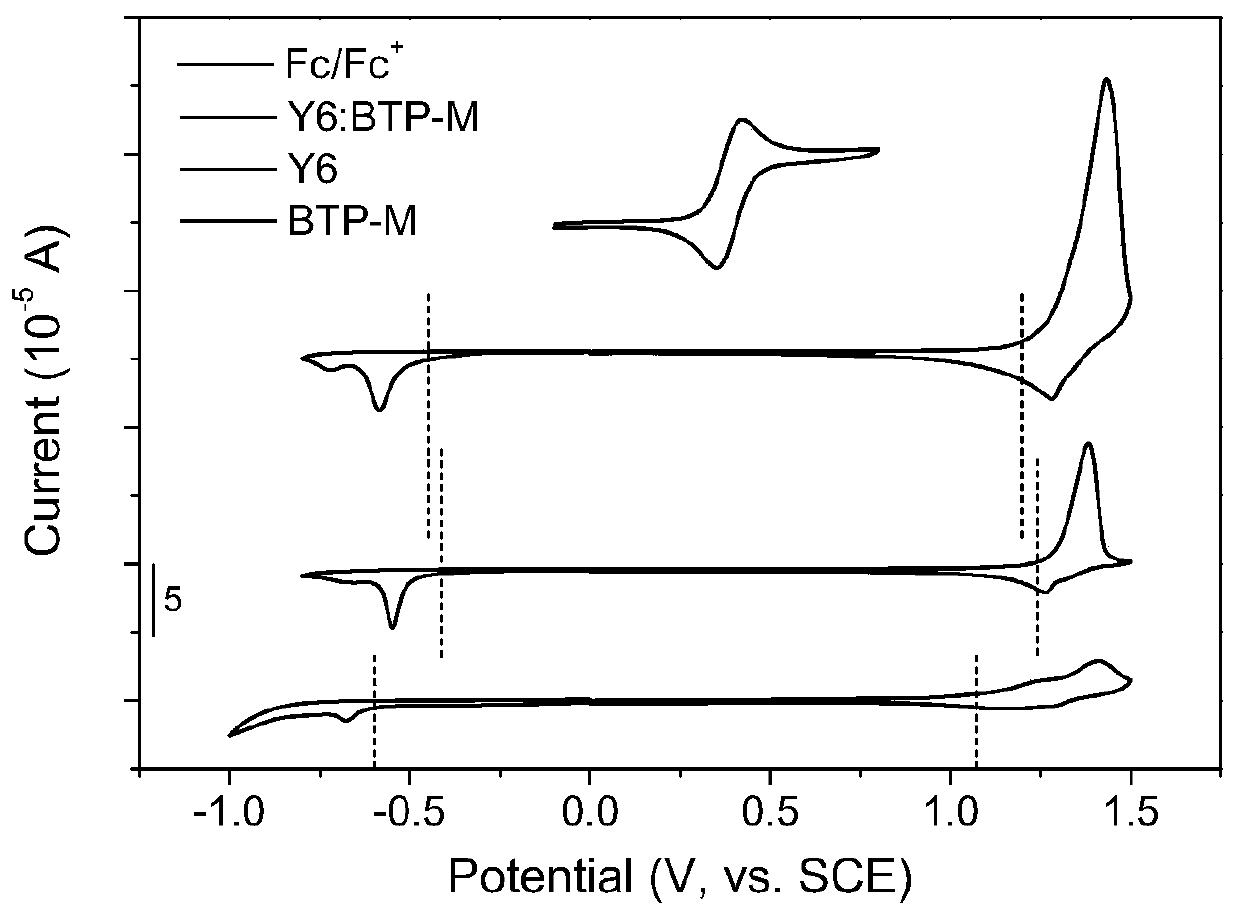High-efficiency ternary organic solar cell based on non-fullerene acceptor alloy
A non-fullerene acceptor, organic solar cell technology, applied in the field of solar cells, achieves the effects of good mutual solubility, improved exciton separation efficiency and strong crystallinity
- Summary
- Abstract
- Description
- Claims
- Application Information
AI Technical Summary
Problems solved by technology
Method used
Image
Examples
Embodiment 1
[0021] BTP-M is synthesized by one-step Knoevenagel reaction, and the specific synthetic route is as follows figure 1 shown.
[0022] The specific synthesis steps of BTP-M are:
[0023] Compound 1 (0.1 g, 0.1 mmol), compound 2 (0.1 g, 0.5 mmol) and dry chloroform (30 mL) were added to the Slack tube, the mixture was frozen with liquid nitrogen, pumped three times, and thawed. Under nitrogen, 0.4 mL of pyridine was added, and then refluxed at 65° C. for 15 h. After removing the solvent, it was purified by column (eluent: petroleum ether:dichloromethane=1:1~0:1, v / v) to obtain a brown solid (85 mg, 60%).
[0024] 1 H NMR (400MHz, CDCl3): δ=9.10(s, 2H), 8.54(d, J=8.1Hz, 0.7H), 8.46(s, 1.3H), 7.87(d, J=7.6Hz, 1.3H) ,7.77(s,0.7H),7.61-7.51(m,2H),4.79(d,J=7.2Hz,4H),3.21(s,4H),2.57(d,J=6.1Hz,6H),2.17 (s,2H),1.95-1.79(m,4H),1.54-1.43(m,4H),1.41-1.17(m,32H),1.15-0.94(m,12H),0.91-0.74(m,12H) ,0.67(t,J=7.2Hz,6H).
[0025] MS(MALDI-TOF): Calcd for C 84 h 94 N 8 o 2 S 5 (M + )...
Embodiment 2
[0029] The transparent conductive glass with strip-shaped ITO (anode) etched on the surface is cleaned with cleaning agent, deionized water, acetone and isopropanol by ultrasonic oscillation, dried, and then treated with ultraviolet ozone for 15 minutes; Spin-coat a layer of PEDOT:PSS with a thickness of 20 nm on the surface at a rotation speed of 4500 rpm, and then anneal at 170° C. for 20 minutes. Then the sheet was transferred to the glove box, and the mixed solution of PM6:Y6 (total weight ratio of 1:1.2) added with 0.5% chloronaphthalene (CN) with a total concentration of 16 mg / mL was spin-coated at a speed of 3500 rpm for 30 seconds, a 115nm thick active layer was obtained. The active layer is annealed at 100° C. for 10 minutes. Then on the active layer, a 5 nm thick PFN-Br transport layer was spin-coated with 0.5 mg / mL PFN-Br methanol solution. Finally, a layer of Ag electrode (cathode) with a thickness of 100nm is vapor-deposited with an evaporation apparatus to obta...
Embodiment 3
[0034] The transparent conductive glass with strip-shaped ITO (anode) etched on the surface is cleaned with cleaning agent, deionized water, acetone and isopropanol by ultrasonic oscillation, dried, and then treated with ultraviolet ozone for 15 minutes; Spin-coat a layer of PEDOT:PSS with a thickness of 20 nm on the surface at a rotation speed of 4500 rpm, and then anneal at 170° C. for 20 minutes. Then the sheet is transferred to the glove box, the BTP-M added with 15% (the weight ratio of BTP-M in the acceptor), the chloronaphthalene (CN) added with 0.5%, the total concentration of PM6 at 16mg / mL :Y6:BTP-M (the total weight ratio of donor and acceptor is 1:1.2) mixed solution, spin coating for 30 seconds at a speed of 3500 rpm, to obtain an active layer with a thickness of 115 nm. The active layer is annealed at 100° C. for 10 minutes. Then on the active layer, a 5 nm thick PFN-Br transport layer was spin-coated with 0.5 mg / mL PFN-Br methanol solution. Finally, a layer of...
PUM
| Property | Measurement | Unit |
|---|---|---|
| thickness | aaaaa | aaaaa |
| thickness | aaaaa | aaaaa |
| thickness | aaaaa | aaaaa |
Abstract
Description
Claims
Application Information
 Login to View More
Login to View More - R&D
- Intellectual Property
- Life Sciences
- Materials
- Tech Scout
- Unparalleled Data Quality
- Higher Quality Content
- 60% Fewer Hallucinations
Browse by: Latest US Patents, China's latest patents, Technical Efficacy Thesaurus, Application Domain, Technology Topic, Popular Technical Reports.
© 2025 PatSnap. All rights reserved.Legal|Privacy policy|Modern Slavery Act Transparency Statement|Sitemap|About US| Contact US: help@patsnap.com



